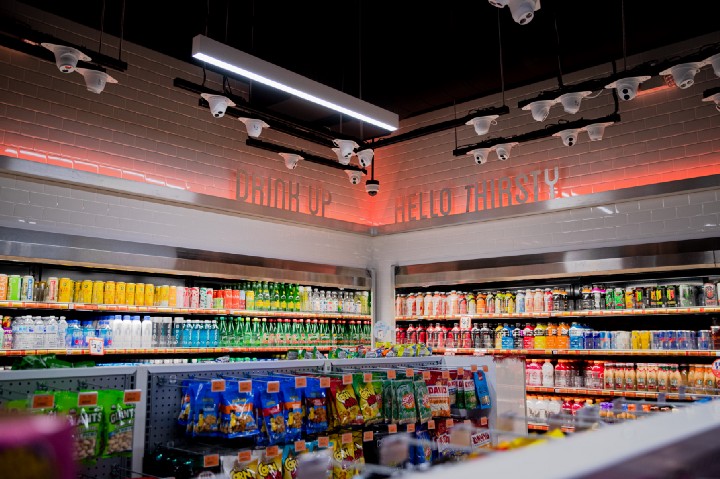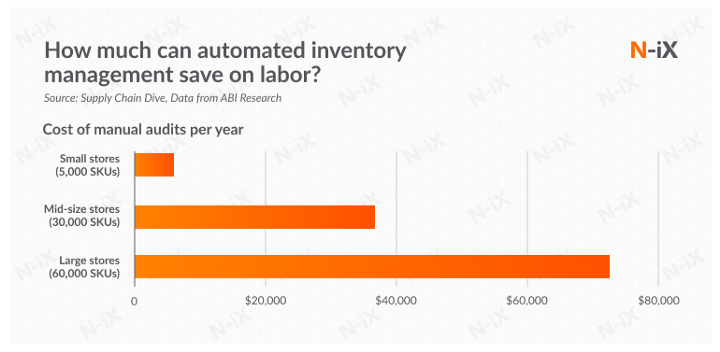
13 Sep - 3 Ways Automation Can Help Grocers Manage Inventory
Inventory management can make or break a retailer, but many businesses are still stuck using obsolete manual processes — or worse, not tracking inventory at all. These inventory management inefficiencies can cause many problems, from wasting money to creating low employee morale, poor vendor relations, and negative customer experiences.
An automated inventory management system is a powerful tool for retailers of any size and provides many competitive advantages. Let’s explore a few key ways automation can boost inventory management for small businesses.
Automated inventory systems help businesses scale quickly
A centralized, packaged inventory management system automates a number of aspects of inventory management, such as performing calculations and accounting processes. Automated inventory systems also increase operational efficiency through collecting and analyzing data.
Inventory management tracks production, shipment, and sales throughout the supply chain. It provides insight into what products are selling and in what volume, as well as where they are being sold. This insight allows retail businesses to scale their inventory up or down in response to real-time sales data.
 Automated inventory management has been proven to save small stores about $6,000 in manual audit costs every year. It speeds up processes, minimizes errors, and highlights opportunities for improvement by reducing administrative and manual tasks as well as the risk of manual error.
Automated inventory management has been proven to save small stores about $6,000 in manual audit costs every year. It speeds up processes, minimizes errors, and highlights opportunities for improvement by reducing administrative and manual tasks as well as the risk of manual error.
All of this culminates in reduced retail shrinkage and improved capability to serve customers.
Maintain a holistic view of inventory at all times
An inventory management system centralizes tracking and provides improved visibility into inventory levels. Inventory management can then be integrated with other business processes in the pipeline, creating a holistic view across the entire supply chain and sales cycle.
Improved product tracking is an important benefit, allowing prioritization of products and advertising for high-sale items. This strategy improves the end-to-end perspective of supply and demand and provides an understanding of what customers are buying and when supply needs to be adjusted to accommodate fluctuations in demand.
Automated inventory systems benefit accountants and financial officers as well; a holistic view of inventory affords better bookkeeping through nearly error-free automatic logging, records of purchases, and easy integration of other overhead costs. They also minimize one of the most overt contributors to retail shrinkage: employee theft.
Improving backend efficiency drives better customer experiences
Automated inventory systems improve backend efficiency across various levels, some of the most critical of which include:
- Better order fulfillment — an automated inventory management platform helps simplify order fulfillment and ensure customers receive exactly what they indicate in their orders, impacting customer demand for customization and meeting expectations.
- Reduced lead times — automated inventory systems respond to demand by ordering inventory and anticipating increased requirements during seasonal surges.
- Sustainable pricing — automated inventory systems provide a bird’s eye view of the margin breakdown, facilitating effective pricing based on the true cost of goods.
An efficient, well-managed backend supports every aspect of a retailer’s business, which in turn culminates in better customer experiences.
Automated inventory management helps businesses scale quicker, maintain a holistic view of inventory at all times, and provide better customer experiences.
Automation improves relations between vendors and retailers
As an additional benefit, inventory management systems help avoid miscommunication and misaligned expectations with vendors, thereby improving the vendor-retailer relationship.
With accurate and automated reporting and forecasting of stock, where items are coming from, and when they’ll arrive, the manual back-and-forth is minimized, reducing missteps in communication. A transparent pipeline of goods makes it clear where accountability lies every step of the way and also helps ease receiving processes, returns, and markdown and stocking procedures.
The accuracy, transparency, and ease of facilitation enabled by automation via inventory management positively affect every stakeholder from customer to retailer to vendor.
As a testament to the efficacy of automation for retailers, the inventory management software market is set to become a $5 billion industry by 2026. Fully automated all-in-one platforms like AiFi’s Orchestrated Autonomous Store Infrastructure & Services (OASIS) are also breaking new ground for retailers.
Facilitating a genuine automated retail experience, OASIS tracks customers from when they enter the store, assesses exactly what they take from shelves, and even enables frictionless checkout through credit cards and payment apps. OASIS is an innovative system that leverages cutting-edge technologies like machine learning and computer vision to create autonomous stores.
If you would like to learn more about how automation can help you manage inventory, request a demo.
If you found this article helpful, please share it on social media.






















